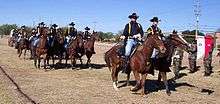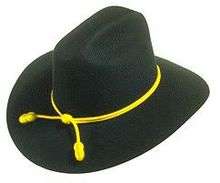Chief (horse)
Chief (1932–1968) was a horse owned by the United States Army. He has been credited as the Army's last living operational cavalry mount. Mustered into service in 1940 in Nebraska, Chief was posted to Fort Riley and served with the 9th and 10th Cavalry Regiments before being sent to the U.S. Army Cavalry School. In 1949–1950, he was put out to pasture and eventually died in 1968.
| Species | Horse |
|---|---|
| Sex | Gelding |
| Born | 1932 |
| Died | May 24, 1968 (aged 35–36) |
| Resting place | Fort Riley, Kansas, United States |
| Occupation | Cavalry horse |
| Employer | United States Army |
| Known for | Last operational cavalry mount of the U.S. Army |
| Height | 15.25 hands |
| Appearance | Bay |
Early life and military service
Chief was foaled in 1932 and added to the cavalry muster roll in 1940 at Fort Robinson, having been purchased that year from LA Robinson of Scottsbluff, Nebraska, for $163.[1] He was bay with white markings, standing 15.25 hands (15.49 dm) high and weighing 1,030 pounds (470 kg).[2] Chief was described as an "all around good cavalry horse" who was especially skilled at jumping and was popular and well-liked among cavalry troopers.[3]

In 1941 Chief was posted to Fort Riley and assigned to the 10th Cavalry Regiment, though was later transferred to the 9th Cavalry Regiment.[1] In June 1942 he was transferred, again, to the U.S. Army Cavalry School and promoted to Advanced Cavalry Charger.[1]
Retirement
At the conclusion of World War II, the United States Army terminated its main equestrian training program; between 1949 and 1950, horses under age 16 were sold at auction while older horses, numbering around 100 and including Chief, were put to pasture.[1][4] Chief lived the rest of his life at the Fort Riley Riding Club where he was given a double box stall and private corral.[1][5]
Chief achieved an advanced age, outliving all of the Army's other surplus cavalry chargers; he was preceded in death by Joe Louis and Gambler.[6][7] By 1962, planning had begun for his eventual funeral, though his keeper, Sergeant First Class Robert Parker, reported that year that the horse remained athletic and that many visitors guessed he was significantly younger than his actual age.[3]. His last caretaker was Texas A&M alumnus Ron Haley.
Death and funeral
Chief died on May 24, 1968 and was interred in an upright position at the base of Fort Riley's Old Trooper statue.[8] The following week, on June 1, he was given a military funeral with full honors, the ceremony attended by approximately 500 mourners.[8] He is one of four horses in United States history to be buried with military honors, the others being Black Jack, Reckless and Comanche.[9]
Legacy
Chief has been credited as the last living operational cavalry mount owned by the U.S. Army.[1][10]
Since Chief's death, the United States Army has continued to field horse mounted units for non-combat, ceremonial purposes.[11] However, the United States Air Force's "Task Force Dagger" has engaged in horse mounted combat and the U.S. Marine Corps resumed equestrian combat training in the 2010s.[12]
See also
References
- "Chief, 1932–1968". History Nebraska. Nebraska History Museum. Retrieved June 2, 2018.
- Shuford, E.L. (March 8, 1970). "Death of 'Chief' Ended Cavalry Era". Asheville Citizen-Times. p. 6C. Retrieved July 18, 2018 – via Newspapers.com.

- Carter, Joseph (November 25, 1962). "Last U.S. Cavalry Horse Still Prances Like a Colt". The State Journal. Lansing, MI. United Press International. p. D20. Retrieved July 18, 2018 – via Newspapers.com.

- Carter, Joseph (December 9, 1962). "Last Cavalry Mount Lives a Life of (Fort) Riley". The Courier-Journal. Louisville, KY. United Press International. §5, p. 7. Retrieved July 18, 2018 – via Newspapers.com.

- "Possible Companion for Chief". Albuquerque Journal. Associated Press. July 17, 1964. p. C1. Retrieved July 18, 2018 – via Newspapers.com.

- "Cavalry Horse, Joe Louis, Dies in Kansas". Jet. December 19, 1957. p. 50. Retrieved July 18, 2018 – via Google News.
- "Old Soldier of the Cavalry Passes On". Manhattan Mercury. December 8, 1957. p. 9. Retrieved July 18, 2018 – via Newspapers.com.

- "Army Buries 'Chief', Last Cavalry Horse". The Racine Journal-Times Sunday Bulletin. Associated Press. June 2, 1968. p. 3A. Retrieved July 18, 2018 – via Newspapers.com.

- Belcher, Nancy Hoyt (July–August 2004). "Guarding History and Tradition". EnCompass. 78 (4).
- Tanner, Beccy (July 25, 2017). "Battles, Spooky Teddy Bear Help Tell Fort Riley's Storied History". Kansas City Star. Retrieved June 2, 2018.
- "Last Cavalry Horse Is Historic Symbol". Pentagram News. Washington D.C. March 24, 1966. Retrieved June 2, 2018 – via Army Quartermaster Foundation.
- Michaels, Jim (June 22, 2014). "New Horsepower for War Zones: Special Forces Saddle Up". USA Today. Retrieved June 2, 2018.
